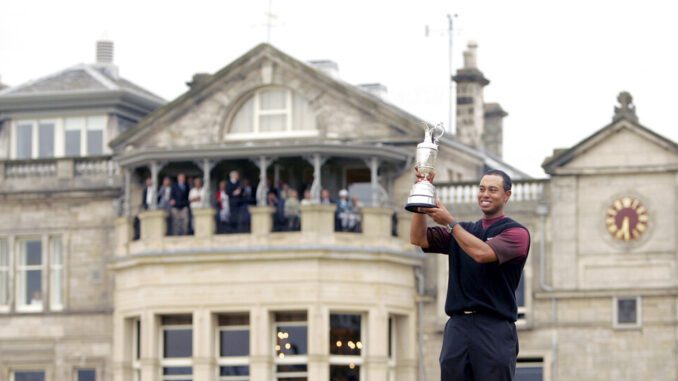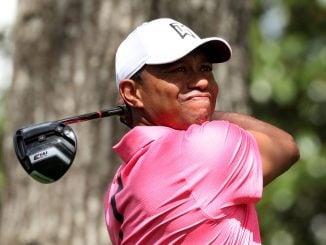
History alone sets the British Open apart from the other majors. Stage it at St. Andrews and it becomes a celebration as much as a championship.
More than 500 years of legend and lore never gets old.
It’s what led Jack Nicklaus to say so famously years ago: “When the British Open is in Scotland, there’s something special about it. And when it’s at St. Andrews, it’s even greater.”
Tiger Woods remarkably returned to major competition at the Masters just 14 months after his right leg and ankle were shattered in a car crash. Even after making the cut, proving he could walk and compete for 72 holes, he was uncertain about where he would play next except for one week he had circled on his calendar.
“I am looking forward to St. Andrews,” Woods said in April. “That is something that is near and dear to my heart. I’ve won two Opens there, it’s the home of golf. It’s my favorite golf course in the world, so I will be there for that one.”
And then there’s Jon Rahm, the former No. 1 player in the world who has seared into his memory that iconic image of Seve Ballesteros twice thrusting his arm into the air after winning the claret jug on the Old Course in 1984.
“To be honest, I don’t think there’s a bigger achievement in golf than winning The Open Championship at St. Andrews,” Rahm said. “I think it’s the biggest event.”
This one figures to be even bigger.
The Open Championship returns to the home of golf on July 14-17 to celebrate the 150th edition of the sport’s oldest championship, which dates to 1860 and was first played at St. Andrews in 1873. This will be the 30th time it’s on the Old Course, the most of any links on the rotation.
Festivities include Nicklaus joining Bobby Jones and Benjamin Franklin as the only Americans to be awarded honorary citizenship of St. Andrews. Nicklaus has not been back to the gray old town since 2005 when he chose the British Open at St. Andrews as the 166th and final major championship of his incomparable career.
“When they wrote and asked me if I would accept being an honorary citizen, I couldn’t turn that down,” the 82-year-old Nicklaus said.
For the players, it doesn’t matter that it’s the 150th playing or the 151st. At stake is a silver claret jug, first awarded at Prestwick in 1872. It seems to shine just a little bit brighter when the claret jug is won at St. Andrews.
There are 138 names on the jug — 22 players are listed multiple times — and the base of the trophy has been expanded over the years. It has the “Great Triumvirate” of Harry Vardon, James Braid and J.H. Taylor. Jones and Gene Sarazen and Walter Hagen. Sam Snead and Ben Hogan, Nicklaus and Arnold Palmer, Lee Trevino and Tom Watson, Nick Faldo and Greg Norman, Woods and Ernie Els and Phil Mickelson.
“Just look at the names on that and you just go right through time,” Woods said. “Everyone who won that championship, they know how hard it was. … And for me specifically to have won at the home of golf is even more special.”
Woods knows that feeling as well as anyone, one of five players to have won the Open twice at St. Andrews. Woods isn’t ruling out a third Open on the Old Course, even at 46 and with nearly as many surgeries as he has won majors.
With his right leg pieced back together following his February 2021 car crash outside Los Angeles, the 15-time major champion made the cut in the Masters and made it to the weekend again at the PGA Championship, withdrawing after the third round when it became too much too walk.
Woods skipped the U.S. Open, wanting to make sure he was at full strength — or the fullest he could expect — for St. Andrews.
“I don’t know when they are ever going to go back while I’m still able to play at a high level,” he said. “And I want to be able to give it at least one more run at a high level.”
Masters champion Scottie Scheffler has a chance to join Faldo as the only players to win at Augusta National and St. Andrews in the same year. They are the most famous places in golf, along with Pebble Beach, and the moment is not lost on Scheffler or anyone else.
“You just want to be part of that history,” Xander Schauffele said.
The Old Course has hardly changed from the last time it held the British Open, in 2015 when Zach Johnson won a three-man playoff. The card of the course is a mere 16 yards longer.
Then again, defense of the Old Course is all about the wind. Woods recalls hitting anything from 9-iron to 3-wood on the par-3 11th. It can be that strong. And it’s been that way for the 600 years golf has been played at St. Andrews, and the 149 years since the first Open was held on the Old Course and Tom Kidd was declared the “champion golfer of the year.”
Who’s next?
All signs point toward youth on the Old Course. The last five major champions are in their 20s, a streak that began with Rahm at the U.S. Open last year, with Matt Fitzpatrick the latest entry from his U.S. Open title last month at Brookline.
And so much depends on the weather. The last time at St. Andrews featured a rare Monday finish because of flooding on Friday and raging wind on Saturday that led to delays of 10 hours. The previous time, in 2010, Rory McIlroy opened with a record-tying 63 only to get caught up in the wind the next day for an 80.
Jordan Spieth said relatively benign conditions could make the Old Course a “wedge contest” because dry conditions make the ball roll forever. Such is the Open on just about any links. John Daly won in a playoff in 1995 at St. Andrews after finishing at 6-under 272. The next time on the Old Course, Woods won at 19 under for an eight-shot margin.
“It was not necessarily built for today’s technology,” Spieth said. “But I think that even a nice 10 to 15 miles an hour would show something to it. And the fact that it doesn’t look like we are going to get any rain, so I think the defense could be how fast it plays.”
Rain or shine, a wee breeze or a gale, it’s still the Open at St. Andrews, a special time and place in any circumstances. It’s not so much making history as adding to it.
As three-time Open champion Sir Henry Cotton said years ago, “Winning The Open Championship can turn a good player into a star, but winning the Open at St. Andrews can turn a great player into a legend.”



